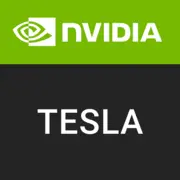NVIDIA Tesla K80

The NVIDIA Tesla K80 GPU is a powerhouse in the professional computing world, offering exceptional performance and capabilities. With a base clock speed of 562MHz and a boost clock of 824MHz, this GPU delivers impressive speed and efficiency for demanding workloads.
The K80 boasts a substantial 12GB of GDDR5 memory and a memory clock of 1253MHz, allowing it to handle large datasets and complex calculations with ease. Its 2496 shading units and 1536KB of L2 cache further contribute to its exceptional computational abilities.
With a TDP of 300W, the K80 is undeniably power-hungry, but its high theoretical performance of 4.113 TFLOPS more than justifies its energy requirements. This GPU is well-suited for professionals and researchers who require substantial computing power for tasks such as deep learning, scientific simulations, and data analysis.
The K80's capabilities shine in applications requiring parallel processing, making it an excellent choice for AI and machine learning workloads. Its reliability and efficiency make it a valuable asset for organizations and individuals in need of high-performance computing solutions.
In conclusion, the NVIDIA Tesla K80 GPU is a top-tier professional computing platform, offering outstanding performance, memory capacity, and parallel processing capabilities. While its power requirements are significant, its exceptional performance makes it an excellent choice for demanding workloads in various industries.
Basic
Label Name
NVIDIA
Platform
Professional
Launch Date
November 2014
Model Name
Tesla K80
Generation
Tesla
Base Clock
562MHz
Boost Clock
824MHz
Bus Interface
PCIe 3.0 x16
Transistors
7,100 million
TMUs
?
Texture Mapping Units (TMUs) serve as components of the GPU, which are capable of rotating, scaling, and distorting binary images, and then placing them as textures onto any plane of a given 3D model. This process is called texture mapping.
208
Foundry
TSMC
Process Size
28 nm
Architecture
Kepler 2.0
Memory Specifications
Memory Size
12GB
Memory Type
GDDR5
Memory Bus
?
The memory bus width refers to the number of bits of data that the video memory can transfer within a single clock cycle. The larger the bus width, the greater the amount of data that can be transmitted instantaneously, making it one of the crucial parameters of video memory. The memory bandwidth is calculated as: Memory Bandwidth = Memory Frequency x Memory Bus Width / 8. Therefore, when the memory frequencies are similar, the memory bus width will determine the size of the memory bandwidth.
384bit
Memory Clock
1253MHz
Bandwidth
?
Memory bandwidth refers to the data transfer rate between the graphics chip and the video memory. It is measured in bytes per second, and the formula to calculate it is: memory bandwidth = working frequency × memory bus width / 8 bits.
240.6 GB/s
Theoretical Performance
Pixel Rate
?
Pixel fill rate refers to the number of pixels a graphics processing unit (GPU) can render per second, measured in MPixels/s (million pixels per second) or GPixels/s (billion pixels per second). It is the most commonly used metric to evaluate the pixel processing performance of a graphics card.
42.85 GPixel/s
Texture Rate
?
Texture fill rate refers to the number of texture map elements (texels) that a GPU can map to pixels in a single second.
171.4 GTexel/s
FP64 (double)
?
An important metric for measuring GPU performance is floating-point computing capability. Double-precision floating-point numbers (64-bit) are required for scientific computing that demands a wide numeric range and high accuracy, while single-precision floating-point numbers (32-bit) are used for common multimedia and graphics processing tasks. Half-precision floating-point numbers (16-bit) are used for applications like machine learning, where lower precision is acceptable.
1371 GFLOPS
FP32 (float)
?
An important metric for measuring GPU performance is floating-point computing capability. Single-precision floating-point numbers (32-bit) are used for common multimedia and graphics processing tasks, while double-precision floating-point numbers (64-bit) are required for scientific computing that demands a wide numeric range and high accuracy. Half-precision floating-point numbers (16-bit) are used for applications like machine learning, where lower precision is acceptable.
4.195
TFLOPS
Miscellaneous
Shading Units
?
The most fundamental processing unit is the Streaming Processor (SP), where specific instructions and tasks are executed. GPUs perform parallel computing, which means multiple SPs work simultaneously to process tasks.
2496
L1 Cache
16 KB (per SMX)
L2 Cache
1536KB
TDP
300W
Vulkan Version
?
Vulkan is a cross-platform graphics and compute API by Khronos Group, offering high performance and low CPU overhead. It lets developers control the GPU directly, reduces rendering overhead, and supports multi-threading and multi-core processors.
1.1
OpenCL Version
3.0
OpenGL
4.6
DirectX
12 (11_1)
CUDA
3.7
Power Connectors
1x 8-pin
Shader Model
5.1
ROPs
?
The Raster Operations Pipeline (ROPs) is primarily responsible for handling lighting and reflection calculations in games, as well as managing effects like anti-aliasing (AA), high resolution, smoke, and fire. The more demanding the anti-aliasing and lighting effects in a game, the higher the performance requirements for the ROPs; otherwise, it may result in a sharp drop in frame rate.
48
Suggested PSU
700W
Benchmarks
FP32 (float)
Score
4.195
TFLOPS
Blender
Score
258
OctaneBench
Score
61
Compared to Other GPU
FP32 (float)
/ TFLOPS
Blender
OctaneBench
Share in social media
Or Link To Us
<a href="https://cputronic.com/gpu/nvidia-tesla-k80" target="_blank">NVIDIA Tesla K80</a>